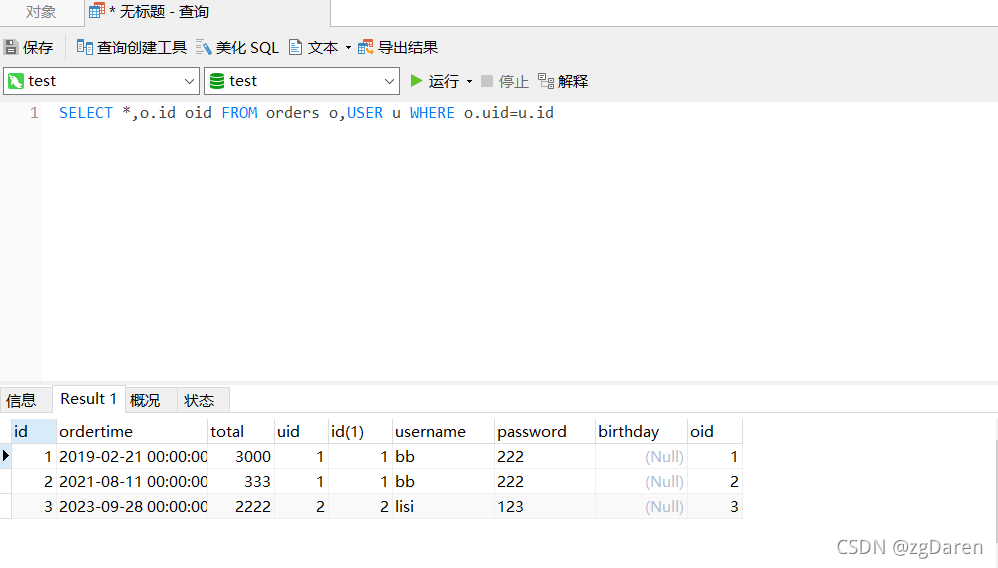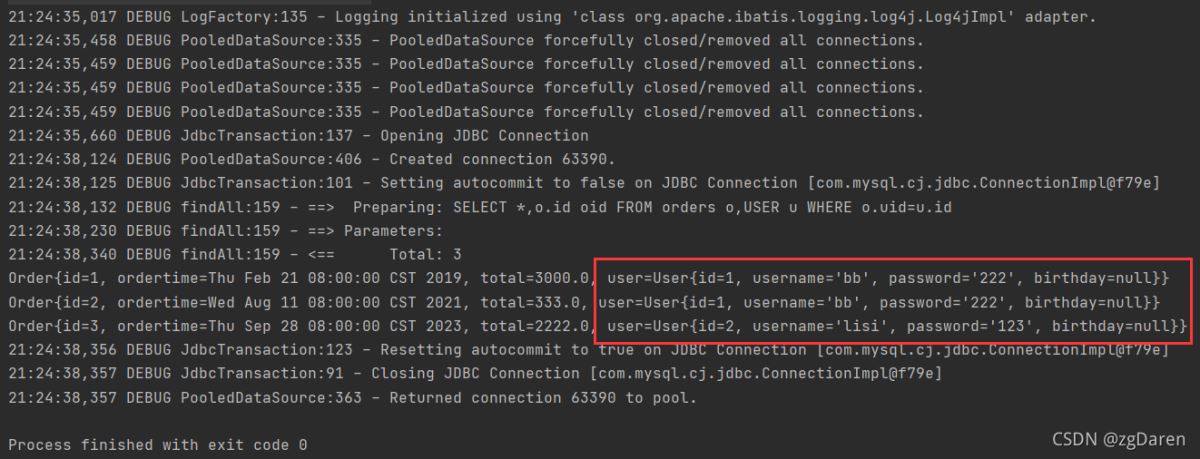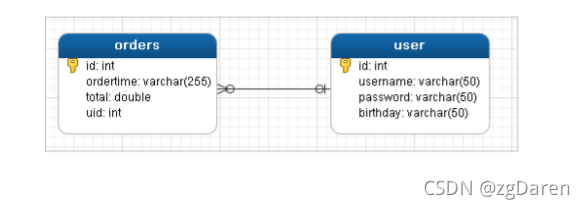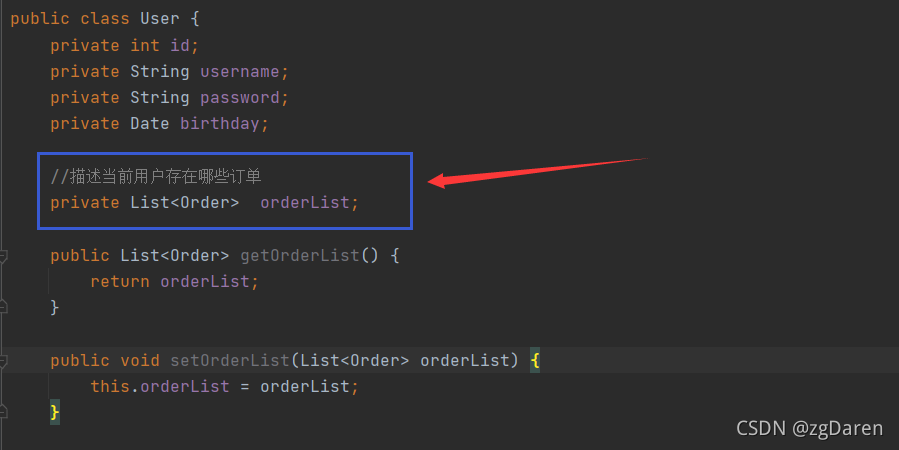小编给大家分享一下MyBatis多表操作查询功能怎么用,希望大家阅读完这篇文章之后都有所收获,下面让我们一起去探讨吧!
用户表和订单表的关系为,一个用户多个订单,一个订单只从属一个用户
一对一查询的需求:查询一个订单,与此同时查询出该订单所属的用户

在只查询order表的时候,也要查询user表,所以需要将所有数据全部查出进行封装SELECT *,o.id oid FROM orders o,USER u WHERE o.uid=u.id

创建Order和User实体
order
public class Order {
private int id;
private Date ordertime;
private double total;
//表示当前订单属于哪一个用户
private User user;user
public class User {
private int id;
private String username;
private String password;
private Date birthday;创建OrderMapper接口
public interface UserMapper {
//查询全部的方法
public List<Order> findAll();
}配置OrderMapper.xml
<?xml version="1.0" encoding="UTF-8" ?> <!DOCTYPE mapper PUBLIC "-//mybatis.org//DTD Mapper 3.0//EN" "http://mybatis.org/dtd/mybatis-3-mapper.dtd"> <mapper namespace="com.zg.mapper.OrderMapper" > <resultMap id="orderMap" type="order"> <!--手动指定字段与实体的映射关系--> <!--comlumn:数据表的字段名称 property:实体的属性名称--> <id column="oid" property="id"></id> <result column="ordertime" property="ordertime"></result> <result column="total" property="total"></result> <result column="uid" property="user.id"></result> <result column="username" property="user.username"></result> <result column="password" property="user.password"></result> <result column="birthday" property="user.birthday"></result> </resultMap> <!--这里不能使用resultType=“order”,因为order中没有user中的字段,只有一个user对象--> <select id="findAll" resultMap="orderMap"> SELECT *,o.id oid FROM orders o,USER u WHERE o.uid=u.id </select> </mapper>
sqlMapConfig.xml
<?xml version="1.0" encoding="UTF-8" ?>
<!DOCTYPE configuration PUBLIC "-//mybatis.org//DTD Config 3.0//EN" "http://mybatis.org/dtd/mybatis-3-config.dtd">
<!--主要配置mybatis的核心配置-->
<configuration>
<!--通过properties标签加载外部properties文件-->
<properties resource="jdbc.properties"></properties>
<!--自定义别名-->
<typeAliases>
<typeAlias type="com.zg.domain.User" alias="user"></typeAlias>
<typeAlias type="com.zg.domain.Order" alias="order"></typeAlias>
</typeAliases>
<!--配置当前数据源的环境-->
<environments default="developement">
<environment id="developement">
<transactionManager type="JDBC"></transactionManager>
<dataSource type="POOLED">
<property name="driver" value="${jdbc.driver}"/>
<property name="url" value="${jdbc.url}"/>
<property name="username" value="${jdbc.username}"/>
<property name="password" value="${jdbc.password}"/>
</dataSource>
</environment>
</environments>
<!--加载映射文件-->
<mappers>
<mapper resource="com.zg.mapper/UserMapper.xml"></mapper>
<mapper resource="com.zg.mapper/OrderMapper.xml"></mapper>
</mappers>
</configuration>
在一对一配置的时候,在order实体中创建了一个user,所以property属性都使用user.** 的方式进行编写,但是这里还可以使用association
<?xml version="1.0" encoding="UTF-8" ?> <!DOCTYPE mapper PUBLIC "-//mybatis.org//DTD Mapper 3.0//EN" "http://mybatis.org/dtd/mybatis-3-mapper.dtd"> <mapper namespace="com.zg.mapper.OrderMapper" > <resultMap id="orderMap" type="order"> <!--手动指定字段与实体的映射关系--> <!--comlumn:数据表的字段名称 property:实体的属性名称--> <id column="oid" property="id"></id> <result column="ordertime" property="ordertime"></result> <result column="total" property="total"></result> <!--<result column="uid" property="user.id"></result> <result column="username" property="user.username"></result> <result column="password" property="user.password"></result> <result column="birthday" property="user.birthday"></result>--> <!--以上被封装到user内的还可以使用association进行配置--> <!--association匹配的意思,在order中有个属性叫user--> <!-- property="user"当前order实体中的属性名称,javaType="user"当前实体order中的属性类型user--> <association property="user" javaType="user"> <id column="uid" property="id"></id> <result column="username" property="username"></result> <result column="password" property="password"></result> <result column="birthday" property="birthday"></result> </association> </resultMap> <!--这里不能使用resultType=“order”,因为order中没有user中的字段,只有一个user对象--> <select id="findAll" resultMap="orderMap"> SELECT *,o.id oid FROM orders o,USER u WHERE o.uid=u.id </select> </mapper>
用户表和订单表的关系为,一个用户有多个订单,一个当但只从属一个用户
一对多查询需求:查询一个用户,与此同时查询出该用户具有的订单

package com.zg.domain;
import java.util.Date;
import java.util.List;
public class User {
private int id;
private String username;
private String password;
private Date birthday;
//描述当前用户存在哪些订单
private List<Order> orderList;
public List<Order> getOrderList() {
return orderList;
}
public void setOrderList(List<Order> orderList) {
this.orderList = orderList;
}
@Override
public String toString() {
return "User{" +
"id=" + id +
", username='" + username + '\'' +
", password='" + password + '\'' +
", birthday=" + birthday +
", orderList=" + orderList +
'}';
}
public int getId() {
return id;
}
public void setId(int id) {
this.id = id;
}
public String getUsername() {
return username;
}
public void setUsername(String username) {
this.username = username;
}
public String getPassword() {
return password;
}
public void setPassword(String password) {
this.password = password;
}
public Date getBirthday() {
return birthday;
}
public void setBirthday(Date birthday) {
this.birthday = birthday;
}
}
修改User实体

package com.zg.domain;
import java.util.Date;
import java.util.List;
public class User {
private int id;
private String username;
private String password;
private Date birthday;
//描述当前用户存在哪些订单
private List<Order> orderList;
public List<Order> getOrderList() {
return orderList;
}
public void setOrderList(List<Order> orderList) {
this.orderList = orderList;
}
@Override
public String toString() {
return "User{" +
"id=" + id +
", username='" + username + '\'' +
", password='" + password + '\'' +
", birthday=" + birthday +
", orderList=" + orderList +
'}';
}
public int getId() {
return id;
}
public void setId(int id) {
this.id = id;
}
public String getUsername() {
return username;
}
public void setUsername(String username) {
this.username = username;
}
public String getPassword() {
return password;
}
public void setPassword(String password) {
this.password = password;
}
public Date getBirthday() {
return birthday;
}
public void setBirthday(Date birthday) {
this.birthday = birthday;
}
}创建UserMapper接口
package com.zg.mapper;
import com.zg.domain.User;
import java.util.List;
public interface UserMapper {
public List<User> findAll();
}配置UserMapper.xml
<?xml version="1.0" encoding="UTF-8" ?> <!DOCTYPE mapper PUBLIC "-//mybatis.org//DTD Mapper 3.0//EN" "http://mybatis.org/dtd/mybatis-3-mapper.dtd"> <mapper namespace="com.zg.mapper.UserMapper" > <resultMap id="userMap" type="user"> <id column="uid" property="id"></id> <result column="username" property="username"></result> <result column="password" property="password"></result> <result column="birthday" property="birthday"></result> <!--配置集合信息--> <!--property:集合名称 ofType:当前集合中的数据类型--> <collection property="orderList" ofType="order"> <!--封装order的数据--> <id column="oid" property="id"></id> <result column="ordertime" property="ordertime"></result> <result column="total" property="total"></result> </collection> </resultMap> <select id="findAll" resultMap="userMap"> select *,o.id oid from user u,orders o where u.id=o.uid </select> </mapper>
测试
@Test//测试一对多
public void test2() throws IOException {
InputStream resourceAsStream = Resources.getResourceAsStream("sqlMapConfig.xml");
SqlSessionFactory sqlSessionFactory = new SqlSessionFactoryBuilder().build(resourceAsStream);
SqlSession sqlSession = sqlSessionFactory.openSession();
UserMapper mapper = sqlSession.getMapper(UserMapper.class);
List<User> userList = mapper.findAll();
for (User user : userList) {
System.out.println(user);
}
sqlSession.close();
}
用户表和角色表的关系为,一个用户有多个角色,一个角色被多个用户使用
多对多查询的需求:查询用户同时查询该用户的所有角色

select * from user u,sys_user_role ur ,sys_role r where u.id=ur.userId and ur.roleId=r.id

创建Role实体,修改User实体

添加UserMapper接口
package com.zg.mapper;
import com.zg.domain.User;
import java.util.List;
public interface UserMapper {
public List<User> findAll();
public List<User> findUserAndRoleAll();
}配置UserMapper.xml
<resultMap id="userRoleMap" type="user"> <!--user信息的封装--> <id column="userid" property="id"></id> <result column="username" property="username"></result> <result column="password" property="password"></result> <result column="birthday" property="birthday"></result> <!--user内部的rolelist信息--> <collection property="roleList" ofType="role"> <id column="roleid" property="id"></id> <result column="roleName" property="roleName"></result> <result column="roleDesc" property="roleDesc"></result> </collection> </resultMap> <select id="findUserAndRoleAll" resultMap="userRoleMap"> select * from user u,sys_user_role ur ,sys_role r where u.id=ur.userId and ur.roleId=r.id </select>
测试代码
@Test//测试多对多
public void test3() throws IOException {
InputStream resourceAsStream = Resources.getResourceAsStream("sqlMapConfig.xml");
SqlSessionFactory sqlSessionFactory = new SqlSessionFactoryBuilder().build(resourceAsStream);
SqlSession sqlSession = sqlSessionFactory.openSession();
UserMapper mapper = sqlSession.getMapper(UserMapper.class);
List<User> userAndRoleAll = mapper.findUserAndRoleAll();
for (User user : userAndRoleAll) {
System.out.println(user);
}
sqlSession.close();
}
看完了这篇文章,相信你对“MyBatis多表操作查询功能怎么用”有了一定的了解,如果想了解更多相关知识,欢迎关注亿速云行业资讯频道,感谢各位的阅读!
免责声明:本站发布的内容(图片、视频和文字)以原创、转载和分享为主,文章观点不代表本网站立场,如果涉及侵权请联系站长邮箱:is@yisu.com进行举报,并提供相关证据,一经查实,将立刻删除涉嫌侵权内容。